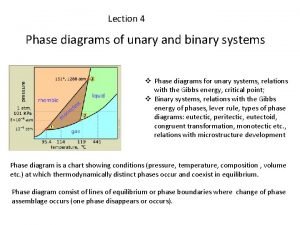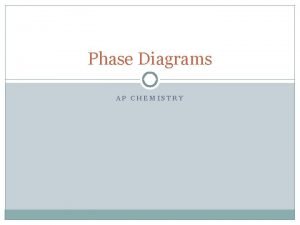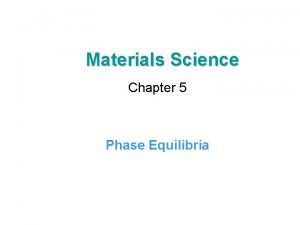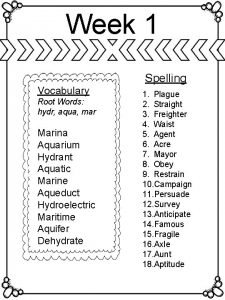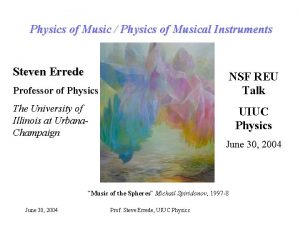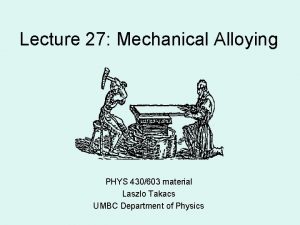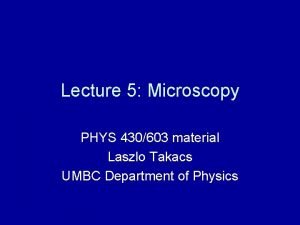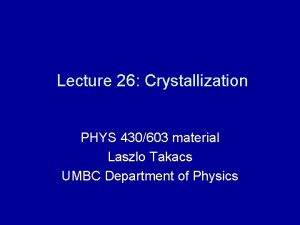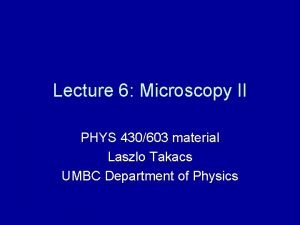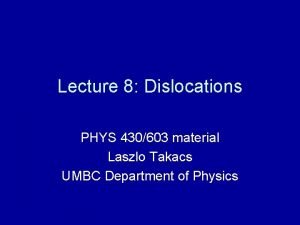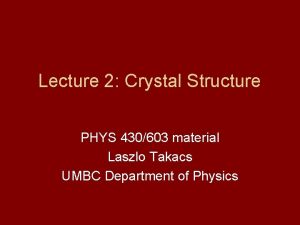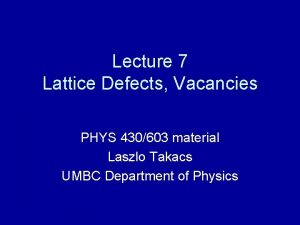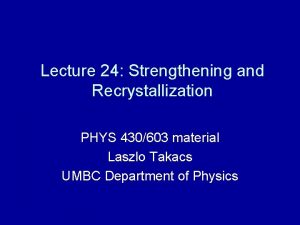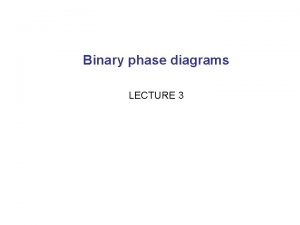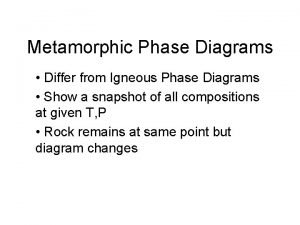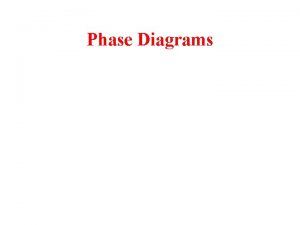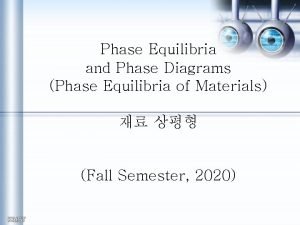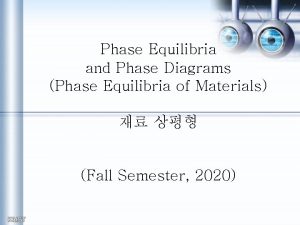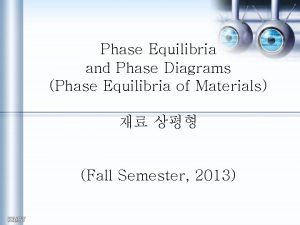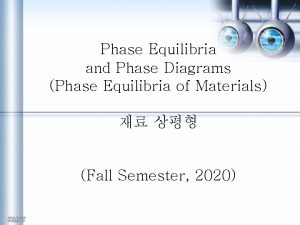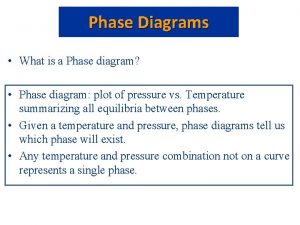Lecture 13 Phase diagrams 2 PHYS 430603 material























- Slides: 23

Lecture 13: Phase diagrams 2 PHYS 430/603 material Laszlo Takacs UMBC Department of Physics

Where are we? • Binary phase diagrams tell us what the stable phases are at a given concentration and temperature. • Simple but important cases: • Ideal solution. Gibbs free energy is dominated by the mixing entropy G = H - TSm Sm = -Nk [c*ln(c) + (1 -c)*ln(1 -c)] Approximates systems with complete solubility. • Regular solution. Beside mixing entropy, differences in bond energy provide a variation of the enthalpy term G = Hm - TSm Hm = 1/2 Nz [(1 -c)HAA + c. HBB + 2 c(1 -c)H 0] H 0 = HAB - 1/2(HAA + HBB) Can result in limited solubility, if H 0 > 0. Read sections 4. 1 -2, 4. 4. 3 -4, and 9. 2. 1. 2 from Gottstein.

Gibbs’ free energy for a regular solution: • H 0 < 0 (strong A-B bonds) makes Gm sharply peaked - ordering, compound formation • H 0 > 0 (strong A-A and B-B bonds) can result in two minima. For c 1 < c 2, the lowest energy state is a mixture - phase separation, limited mutual solubility. If HAA = HBB and c << 1, the solubility limit from d. G/dc = 0 is c 1 = exp(-z. H 0/k. T)

The Au - Pt system: limited solubility in the solid phase Identify the liquidus, solidus, and solvus lines. ( )

Phase separation in the quasi-binary Zr. O 2 - Th. O 2 system

If the curvatures of the free energy curves for liquid and solid are very different, a minimum or maximum of the liquidus and solidus lines (at the same concentration) can occur.

Follow how the common tangents determine the phase composition

The Au - Cu system. Focus on the liquidus and solidus, the features in the solid phase will be discussed later.

The Pb - Tl system. Focus on the maximum at 62. 2%.

If the two-solid region would extend to above the solidus, a peritectic phase diagram results. Here and may derive from a phase separated solid solution or they can be two unrelated phases with different structures. Cooling across a’a results in a peritectic reaction: L+ There are few phase diagrams that show nothing but a peritectic reactions. But peritectic phases are common in more complex phase diagrams.

Gibbs potential curves resulting in a peritectic phase diagram. The minimum of the free energy of the liquid (L) is on the same side of the minima of the free energies for phases and . Notice that the phase compositions are determined by the common tangents of the G(c) curves.

A very rare example. Peritectic reactions are frequent components of complex phase diagrams with many phases, but they rarely occur as the only feature of a phase diagram.

A peritectic reaction dominates the high-temperature part of the phase diagram

Consider a system that has a minimum of the liquidus and solidus curves and also a miscibility gap. (Au-Ni is such a system, see book. ) If the two-solid region would extend above the solidus line, an eutectic phase diagram results. At the end, phases and may derive from a phaseseparated solid solution or they can be two unrelated phases with different structures. Eutectic phase diagrams are very common, both alone and as part of more complex phase diagrams. At the e’e point the eutectic reaction takes place: L +

The eutectic phase diagram can be related to appropriate Gibbs free energy curves. The minimum of the free energy of the liquid (L) is between the minima of the free energies for phases and .

Two typical eutectic systems: Ag - Cu and Pb - Sn (The latter is complicated by the allotropy of Sn. )

Phase diagram helps understanding the solidification process.

A third phase (a compound, ’) appears. Notice that its presence also restricts the solubility limits, even though the minimum is in between the minima for phases ’ and ’.

Similar to the previous diagram, but the third phase has a broader freeenergy minimum and therefore a wider concentration range.

A very sharply defined compound phase. The bond is largely ionic, the compound follows the simple valence rule of chemistry. It also has covalent/ directional character, forms the rather open zinc blende structure. Notice the very high melting point of Al. Sb compared to both Al or Sb; it suggests a very stable compound, strong bonds. Also notice the eutectic points close to the pure element on both sides.

Zr. B 2 and Zr. C: Line compound versus compound with a broad stability range. Zr. B 2 has a relatively complex structure with little flexibility. Zr. C has the Na. Cl structure, C is much smaller than Zr. Notice that a few C sites can easily remain unoccupied, but there cannot be extra C in the structure.

Ca and Mg are chemically quite similar. The sharply restricted composition of the Ca. Mg 2 phase must be the result of size ratio. This is a Laves phase.

 Physics 241
Physics 241 The interaction diagrams, use case diagrams are called as
The interaction diagrams, use case diagrams are called as Uml activity diagram tutorial
Uml activity diagram tutorial 01:640:244 lecture notes - lecture 15: plat, idah, farad
01:640:244 lecture notes - lecture 15: plat, idah, farad Types of binary phase diagram
Types of binary phase diagram Phase diagram ap chemistry
Phase diagram ap chemistry Interpreting phase diagrams
Interpreting phase diagrams Phase diagrams
Phase diagrams Interpreting phase diagrams
Interpreting phase diagrams Column chromatography images
Column chromatography images Broad phase vs narrow phase
Broad phase vs narrow phase Normal phase vs reverse phase chromatography
Normal phase vs reverse phase chromatography Normal phase vs reverse phase chromatography
Normal phase vs reverse phase chromatography M tswett pronunciation
M tswett pronunciation Hplc detector types
Hplc detector types Phase to phase voltage
Phase to phase voltage Mobile phase and stationary phase
Mobile phase and stationary phase In a triangle connected source feeding a y connected load
In a triangle connected source feeding a y connected load Phase change material
Phase change material Saturn facts
Saturn facts Ucsd physics courses
Ucsd physics courses Uiuc physics 101
Uiuc physics 101 Year 10 spelling words
Year 10 spelling words Phys 398 uiuc
Phys 398 uiuc




